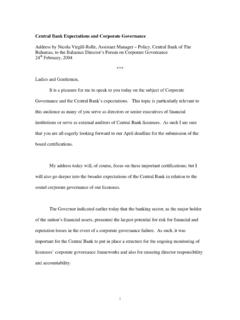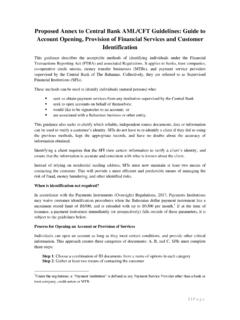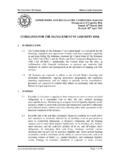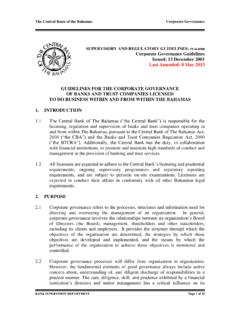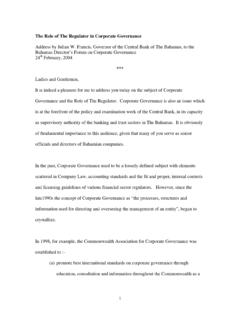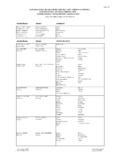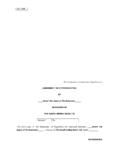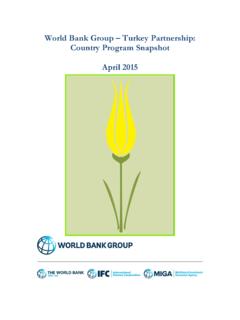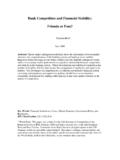Transcription of The Central Bank of The Bahamas DORMANT …
1 The Central bank of The Bahamas DORMANT ACCOUNTS. KEY POINTS ON THE DOMESTIC REGIME AND THE PROPOSED LEGISLATIVE AMENDMENTS. The Central bank of The Bahamas (the Central bank ) is proposing to make changes to the DORMANT accounts law this year. To assist in clarifying the proposed amendments, the Central bank has prepared, in the form of questions and answers, information on the existing regime and an explanation of key aspects of the legislative proposals. The legislative proposals have been issued for public consultation, until 12th Monday May, 2014, and may be found on the Central bank 's website at We invite the public to review the documents and submit any comments by this specified date.
2 The law that deals with DORMANT bank accounts was introduced in 1989, and may be found in what is now section 20 of the Banks and Trust Companies Regulation Act, 2000 (the BTCRA). and section 24 of the Central bank of The Bahamas Act, 2000 (the CBBA). Section 20 of the BTCRA requires banks that have DORMANT accounts to transfer the money in those accounts to the Central bank and to keep all records relating to the DORMANT accounts. Section 24 of the CBBA allows the Central bank to accept the money transferred by banks, in line with section 20 of the BTCRA, to pay interest on that money, and to pay that money (plus interest, if applicable) to any person who is entitled to claim it.
3 1. What is the purpose of the law that deals with DORMANT bank accounts? Many people, for one reason or another, forget about or lose track of their deposit accounts held by banks. The DORMANT accounts law was enacted to protect these people from losing money that banks owe them, in connection with these forgotten accounts. The law provides for money held in DORMANT accounts to be transferred to the custody of the Central bank for safe-keeping when there is no customer-initiated activity on the account for a period of seven (7) years.
4 Currently, money transferred to the Central bank can be claimed at any time by the account owner or other entitled person (for example, by the account owner's heirs or legal representatives). 2. What is a DORMANT account ? Currently, Section 20 of the BTCRA only applies to deposit accounts that contain money, gold bullion or silver bullion that are held at banks and on which the account owner has conducted no transaction for a period of seven (7) years. These accounts are referred to as DORMANT accounts. 3. How will changes in the law affect the definition of DORMANT accounts?
5 When the law is amended later this year, other types of facilities will also be covered by the DORMANT accounts law. These will include any account or arrangement that a person has with a Page | 1 bank that can be used to conduct two (2) or more transactions, including instruments, such as bank drafts, manager's cheques, money orders, travellers cheques, credit card balances, etc. and in connection with which the person conducts no transaction for a period of seven (7) years. Therefore, for example, if a bank is holding a bank draft that has been uncollected, after seven (7).
6 Years it will be transferred to the Central bank . 4. What is an inactive deposit account or facility? Banks classify a deposit account or facility as inactive, if the account owner does not conduct any transaction on the account or facility for a period of at least one (1) year and up to almost seven (7) years. 5. What constitutes a transaction for the purposes of the DORMANT accounts law? A transaction is performed when an account owner conducts some kind of business with a bank in connection with a deposit account or facility that he/she holds with the bank .
7 A transaction includes . (a) the making of a deposit, withdrawal, exchange or transfer of money in any currency, whether in cash, by cheque, payment order, or other instrument on a deposit account or facility; or (b) any communication with, acknowledgement to, request of, or instruction to a bank by a person concerning his/her deposit account or facility held with that bank . An account owner may conduct a transaction in person for example, by walking into his/her bank and making a deposit to his/her account . An account owner may also conduct a transaction by electronic or other non-physical means for example, by going online to check his/her account balance or by instructing his/her bank by telephone to perform a third party transfer from his/her account .
8 The account owner must be the one to initiate the transaction in order to prevent his/her account from becoming inactive. Therefore, the crediting of interest to an account or the debiting of a fee against an account will not constitute a transaction for the purposes of the DORMANT accounts law; because such activities are initiated by the bank and not the account owner. 6. Where the account owner has multiple accounts or facilities with the same bank , will a transaction have to be conducted on each account ? Currently, a transaction is required to be conducted on each account to prevent it from being classified as inactive/ DORMANT .
9 However, the amended law will enable banks to consider all contacts with a customer in deciding whether any one of the customer's accounts should be classified as inactive and, eventually, DORMANT . For example, a customer may have three (3). accounts with a bank a savings account , a fixed deposit account and a mortgage account . The customer may initiate no activity on the account or no communication with the bank in connection with the savings account and fixed deposit account {for more than (7) years}. However, he/she may frequently contact the bank regarding the mortgage account .
10 Because of its contact with the customer in connection with the mortgage account , the bank will be permitted to classify the savings account and fixed deposit account as active. This is because the bank is still in contact with the customer and should have no difficulty letting him/her know that action is required to prevent the other two (2) accounts becoming inactive/ DORMANT . Page | 2 7. What types of accounts and facilities will the amended law cover? The amended law will clearly identify the types of deposit accounts and facilities that it covers.
